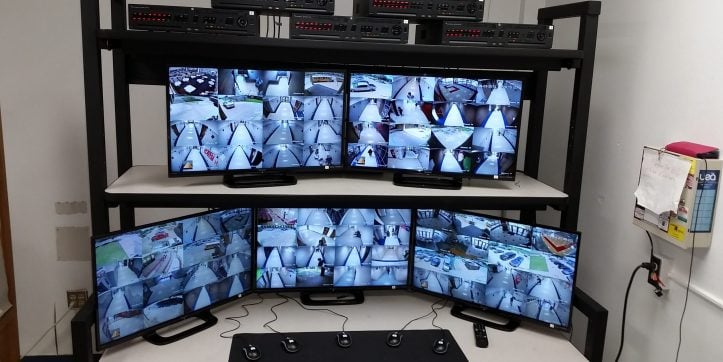Schools receive new security cameras over the summer

Sept. 30, 2015 - The AISD security department worked hard over the summer to install new security cameras funded by the 2014 Bond package. While all AISD campuses will get new cameras over the course of the bond package’s five-year implementation plan, wiring for the first 24 schools will be complete by the end of this year. So far, seven schools have been wired and had the new cameras installed.
Installation of the cameras comes after the AISD’s network services department first wires each school. “We’re following on their coattails,” explained Kevin Burgess, AISD security systems technician, as he checked on progress at Amos Elementary. To be efficient and only take down the ceiling once, network services runs the wire for the cameras while also running wire for network upgrades, upgrading switches and installing additional wireless drops – improvements all also funded by the 2014 Bond package. Once the wiring is in place, the security department installs the cameras.
Burgess said that his department is taking a very strategic approach to placing each camera. David Walker, AISD security systems administrator, explained that years ago each elementary school installed some cameras and then added more later. But this “piecemeal” system of adding cameras to what were already in place is not the best way to provide coverage because it fails to take advantage of spacing. It is better to start from scratch and place all the cameras at the same time so they work together in tandem to provide optimal coverage.
So Burgess and Walker walk each school building to determine the best placement for each security camera. Walking the building is imperative, Burgess insisted; just using a map of the school won’t cut it. By examining the entire campus in person, they can take elements that don’t show up on a floor plan – like landscaping – into consideration.
They start with cameras covering each door from the inside, allowing school and security staff to see everyone who enters and exits. These cameras have infrared illuminators, which permit nighttime surveillance, and are wide dynamic range, which enable a clear picture even when multiple light levels exist within the same scene.
Once the doors are covered, other cameras are deliberately placed throughout the campus to provide as much coverage as possible. With the implementation of the bond, the AISD has set a new standard of 80 percent surveillance coverage at each campus. But the new cameras, coupled with strategic placement, are actually providing even higher coverage at many schools.
These new digital cameras are replacing old analog cameras and provide a better, clearer picture. The digital video taken by the new cameras is saved to a network video recorder (each elementary will have two NVRs, each junior high will have four and each high school will have five), which offers significantly more storage than the old analog recorders. If a principal or assistant principal needs some surveillance video saved, he or she can simply submit a request online and the security department will archive that video indefinitely.
“The increased coverage that the new cameras will provide, along with the ability to store video footage, will assist our campuses in making sure that our students and staff members are safe,” said Michael Hill, AISD assistant superintendent of administration. “I believe the community will be pleased with this use of bond dollars.”
